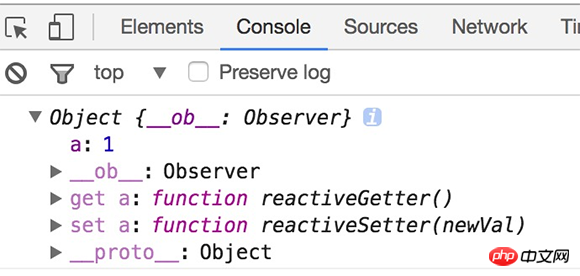
这次给大家带来如何进行Vue数据双向绑定实现,进行Vue数据双向绑定实现的注意事项有哪些,下面就是实战案例,一起来看一下。
一、示例
var vm = new Vue({
data: { obj: { a: 1
} },
created: function ()
{ console.log(this.obj);
} });
二、实现原理
vue数据双向绑定是通过数据劫持结合发布者-订阅者模式的方式来实现的.
1)数据劫持、vue是通过Object.defineProperty()来实现数据劫持,其中会有getter()和setter方法;当读取属性值时,就会触发getter()方法,在view中如果数据发生了变化,就会通过Object.defineProperty( )对属性设置一个setter函数,当数据改变了就会来触发这个函数;
三、实现步骤
1、实现Observer
ok, 思路已经整理完毕,也已经比较明确相关逻辑和模块功能了,let's do it
我们知道可以利用Obeject.defineProperty()来监听属性变动
那么将需要observe的数据对象进行递归遍历,包括子属性对象的属性,都加上 setter和getter
这样的话,给这个对象的某个值赋值,就会触发setter,那么就能监听到了数据变化。。相关代码可以是这样:
var data = {name: 'kindeng'};
observe(data);
data.name = 'dmq'; // 哈哈哈,监听到值变化了 kindeng --> dmq
function observe(data) {
if (!data || typeof data !== 'object') {
return;
}
// 取出所有属性遍历
Object.keys(data).forEach(function(key) {
defineReactive(data, key, data[key]);
});
};
function defineReactive(data, key, val) {
observe(val); // 监听子属性
Object.defineProperty(data, key, {
enumerable: true, // 可枚举
configurable: false, // 不能再define
get: function() {
return val;
},
set: function(newVal) {
console.log('哈哈哈,监听到值变化了 ', val, ' --> ', newVal);
val = newVal;
}
});
}这样我们已经可以监听每个数据的变化了,那么监听到变化之后就是怎么通知订阅者了,所以接下来我们需要实现一个消息订阅器,很简单,维护一个数组,用来收集订阅者,数据变动触发notify,再调用订阅者的update方法,代码改善之后是这样:
// ... 省略
function defineReactive(data, key, val) {
var dep = new Dep();
observe(val); // 监听子属性
Object.defineProperty(data, key, {
// ... 省略
set: function(newVal) {
if (val === newVal) return;
console.log('哈哈哈,监听到值变化了 ', val, ' --> ', newVal);
val = newVal;
dep.notify(); // 通知所有订阅者
}
});
}
function Dep() {
this.subs = [];
}
Dep.prototype = {
addSub: function(sub) {
this.subs.push(sub);
},
notify: function() {
this.subs.forEach(function(sub) {
sub.update();
});
}
};那么问题来了,谁是订阅者?怎么往订阅器添加订阅者?
没错,上面的思路整理中我们已经明确订阅者应该是Watcher, 而且var dep = new Dep();是在 defineReactive方法内部定义的,所以想通过dep添加订阅者,就必须要在闭包内操作,所以我们可以在 getter里面动手脚:
// Observer.js
// ...省略
Object.defineProperty(data, key, {
get: function() {
// 由于需要在闭包内添加watcher,所以通过Dep定义一个全局target属性,暂存watcher, 添加完移除
Dep.target && dep.addDep(Dep.target);
return val;
}
// ... 省略
});
// Watcher.js
Watcher.prototype = {
get: function(key) {
Dep.target = this;
this.value = data[key]; // 这里会触发属性的getter,从而添加订阅者
Dep.target = null;
}
}这里已经实现了一个Observer了,已经具备了监听数据和数据变化通知订阅者的功能,完整代码。那么接下来就是实现Compile了
2、实现Compile
compile主要做的事情是解析模板指令,将模板中的变量替换成数据,然后初始化渲染页面视图,并将每个指令对应的节点绑定更新函数,添加监听数据的订阅者,一旦数据有变动,收到通知,更新视图,如图所示:
图片描述
因为遍历解析的过程有多次操作dom节点,为提高性能和效率,会先将跟节点el转换成文档碎片fragment进行解析编译操作,解析完成,再将fragment添加回原来的真实dom节点中
function Compile(el) {
this.$el = this.isElementNode(el) ? el : document.querySelector(el);
if (this.$el) {
this.$fragment = this.node2Fragment(this.$el);
this.init();
this.$el.appendChild(this.$fragment);
}
}
Compile.prototype = {
init: function() { this.compileElement(this.$fragment); },
node2Fragment: function(el) {
var fragment = document.createDocumentFragment(), child;
// 将原生节点拷贝到fragment
while (child = el.firstChild) {
fragment.appendChild(child);
}
return fragment;
}
};
compileElement方法将遍历所有节点及其子节点,进行扫描解析编译,调用对应的指令渲染函数进行数据渲染,并调用对应的指令更新函数进行绑定,详看代码及注释说明:
Compile.prototype = {
// ... 省略
compileElement: function(el) {
var childNodes = el.childNodes, me = this;
[].slice.call(childNodes).forEach(function(node) {
var text = node.textContent;
var reg = /\{\{(.*)\}\}/; // 表达式文本
// 按元素节点方式编译
if (me.isElementNode(node)) {
me.compile(node);
} else if (me.isTextNode(node) && reg.test(text)) {
me.compileText(node, RegExp.$1);
}
// 遍历编译子节点
if (node.childNodes && node.childNodes.length) {
me.compileElement(node);
}
});
},
compile: function(node) {
var nodeAttrs = node.attributes, me = this;
[].slice.call(nodeAttrs).forEach(function(attr) {
// 规定:指令以 v-xxx 命名
// 如 <span v-text="content"></span> 中指令为 v-text
var attrName = attr.name; // v-text
if (me.isDirective(attrName)) {
var exp = attr.value; // content
var dir = attrName.substring(2); // text
if (me.isEventDirective(dir)) {
// 事件指令, 如 v-on:click
compileUtil.eventHandler(node, me.$vm, exp, dir);
} else {
// 普通指令
compileUtil[dir] && compileUtil[dir](node, me.$vm, exp);
}
}
});
}
};
// 指令处理集合
var compileUtil = {
text: function(node, vm, exp) {
this.bind(node, vm, exp, 'text');
},
// ...省略
bind: function(node, vm, exp, dir) {
var updaterFn = updater[dir + 'Updater'];
// 第一次初始化视图
updaterFn && updaterFn(node, vm[exp]);
// 实例化订阅者,此操作会在对应的属性消息订阅器中添加了该订阅者watcher
new Watcher(vm, exp, function(value, oldValue) {
// 一旦属性值有变化,会收到通知执行此更新函数,更新视图
updaterFn && updaterFn(node, value, oldValue);
});
}
};
// 更新函数
var updater = {
textUpdater: function(node, value) {
node.textContent = typeof value == 'undefined' ? '' : value;
}
// ...省略
};这里通过递归遍历保证了每个节点及子节点都会解析编译到,包括了{{}}表达式声明的文本节点。指令的声明规定是通过特定前缀的节点属性来标记,如<span v-text="content" other-attr中v-text便是指令,而other-attr不是指令,只是普通的属性。
监听数据、绑定更新函数的处理是在compileUtil.bind()这个方法中,通过new Watcher()添加回调来接收数据变化的通知
至此,一个简单的Compile就完成了,完整代码。接下来要看看Watcher这个订阅者的具体实现了
3、实现Watcher
Watcher订阅者作为Observer和Compile之间通信的桥梁,主要做的事情是:
1、在自身实例化时往属性订阅器(dep)里面添加自己
2、自身必须有一个update()方法
3、待属性变动dep.notice()通知时,能调用自身的update()方法,并触发Compile中绑定的回调,则功成身退。
如果有点乱,可以回顾下前面的思路整理
function Watcher(vm, exp, cb) {
this.cb = cb;
this.vm = vm;
this.exp = exp;
// 此处为了触发属性的getter,从而在dep添加自己,结合Observer更易理解
this.value = this.get();
}
Watcher.prototype = {
update: function() {
this.run(); // 属性值变化收到通知
},
run: function() {
var value = this.get(); // 取到最新值
var oldVal = this.value;
if (value !== oldVal) {
this.value = value;
this.cb.call(this.vm, value, oldVal); // 执行Compile中绑定的回调,更新视图
}
},
get: function() {
Dep.target = this; // 将当前订阅者指向自己
var value = this.vm[exp]; // 触发getter,添加自己到属性订阅器中
Dep.target = null; // 添加完毕,重置
return value;
}
};
// 这里再次列出Observer和Dep,方便理解
Object.defineProperty(data, key, {
get: function() {
// 由于需要在闭包内添加watcher,所以可以在Dep定义一个全局target属性,暂存watcher, 添加完移除
Dep.target && dep.addDep(Dep.target);
return val;
}
// ... 省略
});
Dep.prototype = {
notify: function() {
this.subs.forEach(function(sub) {
sub.update(); // 调用订阅者的update方法,通知变化
});
}
};实例化Watcher的时候,调用get()方法,通过Dep.target = watcherInstance标记订阅者是当前watcher实例,强行触发属性定义的getter方法,getter方法执行的时候,就会在属性的订阅器dep添加当前watcher实例,从而在属性值有变化的时候,watcherInstance就能收到更新通知。
四、简单实现方法
<script> var obj = {} Object.defineProperty(obj, 'txt', { get: function () { return obj }, set: function (newValue) { document.getElementById('txt').value = newValue document.getElementById('show-txt').innerHTML = newValue } }) document.addEventListener('keyup', function (e) { obj.txt = e.target.value }) </script>
相信看了本文案例你已经掌握了方法,更多精彩请关注php中文网其它相关文章!
推荐阅读:
The above is the detailed content of How to implement two-way binding of Vue data. For more information, please follow other related articles on the PHP Chinese website!
 How to bind data in dropdownlist
How to bind data in dropdownlist
 what is search engine
what is search engine
 Check disk space in linux
Check disk space in linux
 Solution to sql procedure syntax error
Solution to sql procedure syntax error
 Introduction to commonly used top-level domain names
Introduction to commonly used top-level domain names
 How to switch cities on Douyin
How to switch cities on Douyin
 How to open scope permissions
How to open scope permissions
 A memory that can exchange information directly with the CPU is a
A memory that can exchange information directly with the CPU is a
 Introduction to the usage of axis function in Matlab
Introduction to the usage of axis function in Matlab




